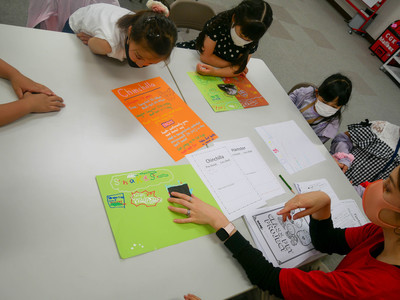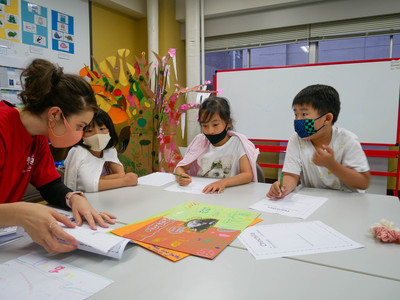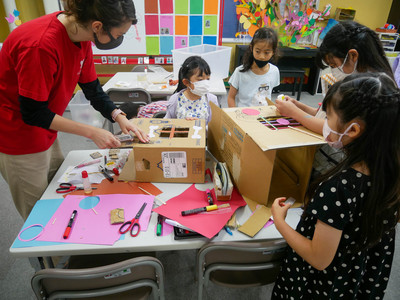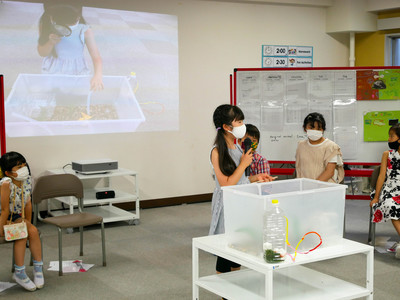Science Lesson for Project Work/サイエンスレッスン紹介
Here is an introduction to lessons at CGK Afterschool.
CGKアフタースクールでのレッスンについて紹介いたします。
CGK’s two-month-long project works will be based on the main “Driving Question”.
Here are the Driving Questions for this “Science” lesson.
CGKの2ヶ月間に渡って行うプロジェクト活動では、メインとなる”Driving Question”に基づいて学んでいきます。
今回の「サイエンス」レッスンでのDriving Questionはこちらです。
“What animal is best to be a class pet for CGK Afterschool?”
CGKアフタースクールに適したペットは何でしょうか?
We followed this question with fun lessons each week that drew the student’s interest.
Here are the comments of Ms. Kitty, the teacher who was in charge of the lessons.
この問いに沿って、毎週子供たちの興味を引き出す楽しいレッスンを行いました。
担当していたKitty先生のコメントをご紹介します。

Week 1
Students were introduced to the project by discussing what a pet is, examples of pets that people have at home and what you do with a pet. As a group we looked through a slideshow of different pictures and the students were able to comment on whether they like or didn`t like the animals, and I would ask whether they would be an appropriate pet for CGK. They were able to think about whether or not the animal is easy to care for, how much noise it makes, and what food it would eat. The Guinea Pig was very popular with the class and everyone enjoyed listening to the sounds they make. We then used an online simulator to mix different parts of animals bodies to make funny animals. The students then worked on a worksheet to create their own unique animal that could be a pet, thinking about different parts of the body and characteristics such as the size, colour, what it sounds like and what it eats. Once they were finished they were able to create a crazy animal using any type of animal. These drawings were then presented to the group and their friends were able to ask any questions they had.
1週目
生徒たちはこのプロジェクトの導入として、ペットとは何か、人々が家で飼っているペットの例、ペットと一緒に何をするかなどを話し合いました。グループで様々な動物の写真のスライドショーを見て、生徒たちはその動物が好きか嫌いかについてコメントすることができ、先生からその動物はCGKのペットとしてふさわしいかどうか尋ねられました。世話がしやすいかどうか、鳴き声が大きいかどうか、どんな食べ物を食べるかなどを考えてもらいました。モルモットはクラスでとても人気があり、みんなで鳴き声を聞いて楽しみました。その後、オンライン・シュミレーターを使って、動物の体の色んな部分を混ぜ合わせ、面白い動物を作りました。そして今度は、体の様々な部分や、大きさ、色、鳴き声、食べ物などの特徴を考えて、ペットにできそうな自分だけのオリジナル動物を作りそのワークシートを作成しました。いざその作業が終わってみると、色んな種類の動物が使われた風変りな動物が出来上がっていました。描いた絵はグループ内で発表され、質問をし合うことができました。
Week 2
Students discussed key factors which would need to be considered when thinking about a CGK pet. Factors such as weight, size, diet, temperament etc. After discussing these students broke into two teams and researched various pets using the tablets and information packs. After working together to write about their chosen animals, students then worked on posters that could display the information they had researched in a bright and colorful way.
2週目
生徒たちは、CGKのペットを考える際に考慮すべき大切な要素について話し合いました。重さ、大きさ、食事、気質などの要素です。話し合いの後、生徒たちは2つのチームに分かれて、タブレットと情報集を使ってさまざまなペットについて調べました。そして、自分たちの選んだ動物について調べたことを皆で書いていき、それらをまとめた明るくカラフルなポスターを作成しました。
Week 3
As a group we reviewed the posters that were made in week 2 and the students had learnt some interesting facts about the animals which they were very enthusiastic to share. We discussed whether they thought the animals were appropriate to have as a CGK afterschool pet, and the students were able to agree or disagree with each other. Each student then worked on a Pros (good) and Cons (bad) worksheet for a chosen animal and thought of key factors that were either positives or negatives about the animal. These ideas were presented and students were able to make additional comments. They then voted on what they thought would be the best pet, 3 students voted for dog, 1 student voted for fish, 1 voted for chinchilla and 2 students voted for a chameleon. The students then started to work on initial designs of the cages for the animal they voted for and the students that finished their designs talked them through with Ms Kitty.
3週目
グループで第2週に作成したポスターを見直したところ、生徒たちは動物についての興味深い事実を知り、それを熱心に話してくれました。CGKのアフタースクールでペットとして飼うのに適しているかどうかを話し合い、生徒たちはお互いに賛成、反対の意見を出し合いました。続いて、それぞれが選んだ動物の長所と短所のワークシートを作成し、その動物の長所と短所のどちらにも当てはまる重要な要素を考えました。それらのアイディアは発表され、コメントを加えることができました。その後自分が一番ペットに向いていると思う動物に投票することになり、3人の生徒が犬、1人は魚、1人はチンチラ、2人はカメレオンに投票しました。投票の後は、投票した動物のケージの初期デザインに取り掛かり、デザインを完成させた生徒はキティ先生と一緒にそのデザインについて話しました。


Week 4
As a group we sat and reviewed the initial designs the students had made, having them explain the design, what the different parts are, how big it would be and any additional information they had to share, while their friends asked questions and gave feedback. After we discussed how different pets require different amounts of care and some, such as a dog, need a lot of attention. Ms Kitty explained that the students had a survey they needed to complete by asking the teachers and their friends different questions about their chosen animal, such as do you like this animal? Would you be able to take this animal home to look after? Will you be happy feeding this animal? Will the CGK Pet disturb your family home? Once the students had been given enough time to ask the questions to their friends and teachers, we regrouped to see whether their opinions of whether they thought the animal was an appropriate pet. The chameleon wasn`t a popular choice as no one would be happy to feed it bugs, the dog would be difficult to take care of out of CGK afterschool hours, and the parrot had people divided. Fish and Chinchilla were popular with everyone. The students voted again on whether they wanted to just focus on making cages for Fish and Chinchilla`s, or their own animals, and they voted to make different animal cages. The students also submitted a list of materials they need for the next lesson.
4週目
グループにて、生徒たちが作ったケージの初期デザインを見直しました。生徒たちは、デザインや各パーツの特徴、大きさ、その他知ってもらいたいことに関して説明をし、もう一つのグループの皆はそれに対し質問や意見を述べました。その後、ペットの種類によって必要なケアの量が異なり、犬のようにより注意が必要となるペットもいることを話し合いました。キティ先生の説明によると、生徒たちは先生や友達に自分の選んだ動物について様々な質問をし、答えてもらうことによって回答用紙を埋めなければいけない、というアンケートを行ったようです。そのアンケートの質問には、「この動物を家に連れて帰って世話をすることができますか?」「この動物にエサをあげると幸せになりますか?」「CGKのペットはあなたの家ではお邪魔になりませんか?」といったものがありました。生徒たちが友達や先生に質問する時間を十分にとった後、その動物がペットとしてふさわしいかどうかの意見を確認するため、再度グループを作りなおしました。カメレオンはエサとして虫をあげるので人気がなく、犬だとCGKアフタースクールの時間外に世話をするのは難しく、オウムに関しては人によって意見が分かれました。魚とチンチラは皆に人気がありました。生徒たちは、魚とチンチラに絞ってそのケージを作ることにするか、自分たちのそれぞれの動物のケージを作ることにするかを再度投票し、それぞれ違った動物のケージを作ることになりました。また、次のレッスンで必要な材料のリストも提出されました。

Week 5
The students started to make their animal cages. They were using a variety of materials to build things for the pets and thinking about where things were going within the boxes. Everyone worked well and stayed focused.
5週目
生徒たちは、動物のケージを作り始め、様々な材料を使ってペットの為に必要なものを作り、箱(ケージ)の中のどこに設置するか考えていました。みんな集中して作業していました。
Week 6
The students continued to work on their pet living environments and made a lot of progress. If they finished, they began to think about the schedule of caring for the animal, such as feeding, walking, cleaning.
6週目
生徒たちは、ペットの住環境の製作を続け、かなりの成果を上げました。完成すれば、餌やり、散歩、掃除などのお世話のスケジュールを考え始めました。

Week 7
The students were thinking and planning the care schedules of their chosen pets, asking their friends whether they would be able to feed/clean/play/walk the animals on the other days they are at CGK. If they had finished all their planning they were able to make any last minute adjustments to their pet cages, and started to sew felt plushies to have inside their cages for presentation.
7週目
生徒たちは、自分たちが選んだペットのお世話スケジュールを考え、他の曜日にCGKに来るお友達たちに、代わりに動物たちに餌をやったり、掃除をしたり、遊んだり、散歩をしたりできるかどうかを尋ねていました。計画作りが全て終わった後は、ペットのケージを最後まで調整したり、ケージの中に入れるフェルトのぬいぐるみを縫い始めたりして、プレゼンテーションに備えました。
Week 8
The students reviewed the scripts and practiced talking about their animal cages in pairs to help them prepare for the final presentation.
8週目
最後の発表に向けて、台本を見直したり、ペアで動物のケージについて話す練習をしたりしました。

In their final presentation, the students skillfully explained the pet cages they had built.
Each animal had different food and playthings, so we could learn from the student's presentations.
最終プレゼンテーションでは、子供たちが製作したペットのケージについて上手に説明してくれました。
それぞれの動物で餌や遊び道具が異なるので、子供たちの発表から学ぶこともできました。
The chameleon group looked very happy with their presentation, as they were very creative in the way they fed their animals.
カメレオングループは、餌のあげ方を工夫していてとても楽しそうに発表していました。
All of the students, those who have pets and those who do not, were able to think deeply about taking care of animals in this lesson.
We were able to see another growth of the children after completing the project.
ペットを飼っている子、飼っていない子、どの子たちも動物の世話をするということについて深く考えることができたレッスンになりました。
また一つ、プロジェクトを終えた子供たちの成長を見ることができました。
Author Profile
-

-
Saeda Sueki-Au-Yeung - School Director (Japan)

School Director of CGK International School.
Graduated from a 4-year university in America, joined women's soccer team (National Champion).
After working in childcare and management at CGK Preschool and CGK Afterschool, she became the director of the entire CGK International School.





















